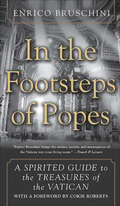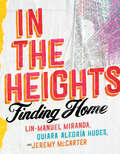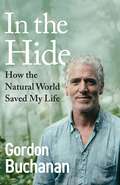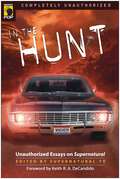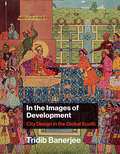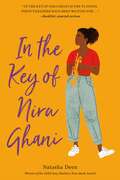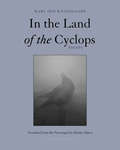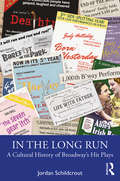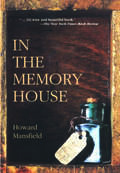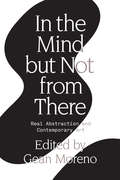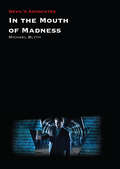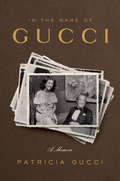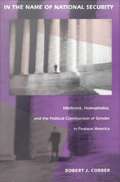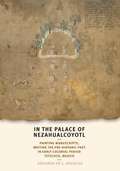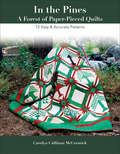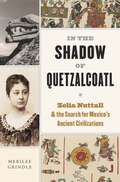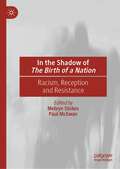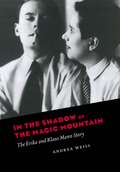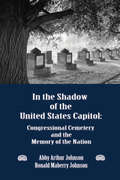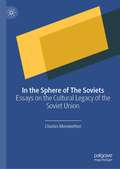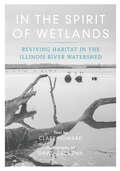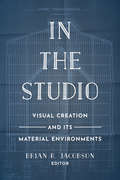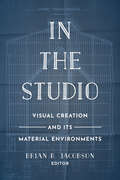- Table View
- List View
In the Footsteps of Popes: A Spirited Guide to the Treasures of the Vatican
by Enrico BruschiniA unique look at the treasures of the Vatican Museums, the Sistine Chapel, and the Basilica of Saint Peter from an official guide of the Eternal City.In a tiny enclave in the heart of Rome lies the world's smallest independent state—the Vatican. Over the course of fifteen hundred years, successive popes have commissioned and assembled an extraordinary collection of artistic works within Vatican walls.Eminent expert Professor Enrico Bruschini takes readers on a fascinating personal tour through the Vatican's magnificent sacred halls, vividly bringing to life works by Raphael, da Vinci, Caravaggio, Michelangelo, and many others, while sharing interesting curiosities about the artists, their art, and the historical context in which they worked. Bruschini's unprecedented access to areas rarely open to the public enables him to offer a unique behind-the-scenes tour that reveals the Vatican's most intimate secrets and hidden treasures. With maps and rare photographs from the Vatican archives, In the Footsteps of Popes is an extraordinary excursion that is not to be missed.
In the Heights: Finding Home
by Quiara Alegría Hudes Lin-Manuel Miranda Jeremy McCarterThe eagerly awaited follow-up to the #1 New York Times bestseller Hamilton: The Revolution, Lin-Manuel Miranda’s new book gives readers an extraordinary inside look at In the Heights, his breakout Broadway debut, written with Quiara Alegría Hudes, now a Hollywood blockbuster. <P><P>In 2008, In the Heights, a new musical from up-and-coming young artists, electrified Broadway. The show’s vibrant mix of Latin music and hip-hop captured life in Washington Heights, the Latino neighborhood in upper Manhattan. It won four Tony Awards and became an international hit, delighting audiences around the world. For the film version, director Jon M. Chu (Crazy Rich Asians) brought the story home, filming its spectacular dance numbers on location in Washington Heights. <P><P>That’s where Usnavi, Nina, and their neighbors chase their dreams and ask a universal question: Where do I belong? In the Heights: Finding Home reunites Miranda with Jeremy McCarter, co-author of Hamilton: The Revolution, and Quiara Alegría Hudes, the Pulitzer Prize–winning librettist of the Broadway musical and screenwriter of the film. <P><P>They do more than trace the making of an unlikely Broadway smash and a major motion picture: They give readers an intimate look at the decades-long creative life of In the Heights. Like Hamilton: The Revolution, the book offers untold stories, perceptive essays, and the lyrics to Miranda’s songs—complete with his funny, heartfelt annotations. It also features newly commissioned portraits and never-before-seen photos from backstage, the movie set, and productions around the world. This is the story of characters who search for a home—and the artists who created one. <P><P><b>A New York Times Best Seller</b>
In the Hide: The Instant Sunday Times Bestseller: How The Natural World Saved My Life
by Gordon BuchananOur estate was built on land claimed from fields – we were at the foot of those rolling Kilpatrick hills, but over the roof of the school you could see more green fields and woods. I felt grateful to be on the edge of all that countryside – there was a magnetic pull towards what I thought that wild was, or could be. ‘One day, I’m going to walk to those hills and woods,’ I’d think to myself.Soon, it would become a sanctuary.Gordon Buchanan is probably the best-known natural history cameraman the BBC has ever produced. From wild snow wolf packs in Ellesmere and polar bears in Svalbard to leopards in Mumbai and equine therapy in Mongolia, he has filmed in the world's most far-reaching places for over 30 years. His dedication to his craft means he often spends weeks inside a cramped camera hide, tolerating extreme sleep deprivation and poor living conditions, all in search of that one extraordinary shot.But dangerous animals were not the only thing he was hiding from.In the Hide is Gordon's emotionally honest and raw account of a challenging childhood in Dumbarton and on Mull, and the escape and solace he found – and continues to find – in the natural world around him. An intimate and inspiring account of resilience in the face of hardship, In the Hide marks the arrival of a bold new voice in nature writing.
In the Hunt: Unauthorized Essays on Supernatural
by Supernatural TvA relative newcomer to the paranormal-teen drama scene, the hit TV show Supernatural has already developed a rabid and deeply committed fan base since its debut in the fall of 2005. When their dad mysteriously disappears, brothers Dean and Sam Winchester join forces to bring him home and are pulled headlong into the world he knew best-one full of demons, spirits, monsters, and ghouls. Featuring essays from three lucky fans as well as leading writers and pop culture experts, this insightful anthology sheds light on a variety of issues, including why such a male-centric show has such a large female fan base, "Wincest" and homoeroticism, how Supernatural can be interpreted as a modern-day Brothers Grimm, and the questionable nature of John Winchester's parenting habits.
In the Images of Development: City Design in the Global South (Urban and Industrial Environments)
by Tridib BanerjeeThe urban legacy of the Global South since the colonial era and how sustainable development and environmental and social justice can be achieved. Remarkably little of the expansive literature on development and globalization considers actual urban form and the physical design of cities as outcomes of these phenomena. The development that has shaped historic transformations in urban form and urbanism—and the consequent human experiences—remains largely unexplored. In this book, Tridib Banerjee fills this void by linking the idea of development with those of urbanism, urban form, and urban design, focusing primarily on the contemporary cities in the developing world—the Global South—and their intrinsic prospects in city design. Further, he examines the endogenous possibilities for the future design of these cities that may address growing inequality and the environmental crisis. Banerjee deftly traces the urban legacy of the Global South from the beginning of the colonial era, closely examining the economic, political, and ideological forces that influenced colonial and postcolonial development, drawing from relevant experiences of different cities in the developing world and discussing the arguments for the historic parity of these cities with their Western counterparts. Finally, Banerjee considers essential notions of future city design that are grounded in the critical challenges of sustainable development, equity, environmental and social justice, and diversity, and how such outcomes can be achieved. This book serves as the opening of a long overdue conversation among design, development, and planning scholars and practitioners, and those interested in the urban development of the Global South.
In the Key of Nira Ghani
by Natasha DeenNira Ghani has always dreamed of becoming a musician. Her Guyanese parents, however, have big plans for her to become a scientist or doctor. Nira's grandmother and her best friend, Emily, are the only people who seem to truly understand her desire to establish an identity outside of the one imposed on Nira by her parents. When auditions for jazz band are announced, Nira realizes it's now or never to convince her parents that she deserves a chance to pursue her passion. <p><p> As if fighting with her parents weren't bad enough, Nira finds herself navigating a new friendship dynamic when her crush, Noah, and notorious mean-girl, McKenzie "Mac," take a sudden interest in her and Emily, inserting themselves into the fold. So, too, does Nira's much cooler (and very competitive) cousin Farah. Is she trying to wiggle her way into the new group to get closer to Noah? Is McKenzie trying to steal Emily's attention away from her? As Farah and Noah grow closer and Emily begins to pull away, Nira's trusted trumpet "George" remains her constant, offering her an escape from family and school drama. <p> But it isn't until Nira takes a step back that she realizes she's not the only one struggling to find her place in the world. As painful truths about her family are revealed, Nira learns to accept people for who they are and to open herself in ways she never thought possible. <p> A relatable and timely contemporary, coming-of age story, In the Key of Nira Ghani explores the social and cultural struggles of a teen in an immigrant household.
In the Kitchen with Kris: A Kollection of Kardashian-Jenner Family Favorites
by Kris JennerFrom America's favorite momager comes a new cookbook and entertainment guide filled with Kris Jenner's very own insightful tips and favorite recipes.Kris Jenner has done everything under the sun from starring as the matriarch in Keeping Up With the Kardashians to writing a New York Times bestselling memoir entitled Kris Jenner... And All Things Kardashian. Inside this incredible cookbook, you'll find nearly 70 favorite recipes that have become the centerpiece of Kardashian-Jenner family traditions. This book is another way to bring fans into Kris's home with recipes and entertaining tips that can be used by anyone and everyone. Join Kris as she rolls up her sleeves to dish out tips on how to do it all and have it all in her new cookbook/entertainment guide.
In the Land of the Cyclops
by Karl Ove KnausgaardFrom New York Times bestselling author Karl Ove Knausgaard comes a collection of ambitious, remarkably erudite essays on art, literature, culture, and philosophy.In the Land of the Cyclops is Karl Ove Knausgaard's first collection of essays to be published in English. In these wide-ranging pieces, Knausgaard reflects openly on Ingmar Bergman's notebooks, Anselm Kiefer, the Northern Lights, Madame Bovary, Rembrandt, and the role of an editor with penetrating intelligence. Accompanied by color reproductions throughout, these essays illuminate Cindy Sherman's shadowlands, the sublime mystery of Sally Mann's vision, and the serious play of Francesca Woodman. These essays capture Knausgaard's remarkable ability to mediate between the personal and the universal, between life and art. Each piece glimmers with Knausgaard's candor and his longing to authentically see, understand, and experience the world.
In the Long Run: A Cultural History of Broadway’s Hit Plays
by Jordan SchildcroutIn the Long Run: A Cultural History of Broadway’s Hit Plays presents in-depth analysis of 15 plays that ran over 1,000 performances, examining what made each so popular in its time—and then, in many cases, fall into obscurity. Covering one hundred years of theatre history, it traces the long-running Broadway play as a distinct cultural phenomenon that rises and falls from 1918 to 2018. Each chapter focuses on the longest-running plays of a particular decade, synthesizing historical research and dramaturgical analysis to explain how they functioned as works of theatrical art, cultural commodities, and reflections of the values, conflicts, and fantasies of their times. At the heart of each play’s history are the ideological contradictions often present in works of popular culture that appeal to diverse audiences, particularly around issues of gender, race, class, and sexuality. Suitable for anyone with an interest in Broadway and its history, In the Long Run explores the nature of time in this ephemeral art form, the tensions between commerce and art, between popularity and prestige, and the changing position of the Broadway play within American popular culture.
In the Memory House
by Howard MansfieldIn the Memory House recalls what American society has forgotten--the land, its people, and its ideals. By examining what we choose to remember, this important book reveals how progress has created absences in our landscapes and in our lives.
In the Mind But Not From There: Real Abstraction and Contemporary Art
by Gean MorenoArtists and critics explore the concept of Real Abstraction to help understand contemporary cultural productionIn the Mind, But Not From There: Real Abstraction and Contemporary Art considers how the Marxian concept of Real Abstraction--originally developed by Alfred Sohn Rethel, and recently updated by Alberto Toscano--might help to define the economic, social, political, and cultural complexities of our contemporary moment. In doing so, this volume brings together noted contemporary artists, literary critics, curators, historians, and social theorists who connect the concept of Real Abstraction with contemporary cultural production. Theoretical and artistic contributions from Benjamin Noys, Paul Chan, Joao Enxuto and Erica Love, Marina Vishmidt, Sven Lütticken, and many others help to map out the relationship between political economy and artistic production in the realm of contemporary, globalized cultural exchange. This anthology places economic and social analyses alongside creative projects and visual essays to consider the many angles of contemporary art, and how inquiry into the the production of abstraction through material and social processes can be used to better understand, and hopefully change, the conditions under which art is made, seen, and circulated today.Published in collaboration with [NAME] publications.
In the Mouth of Madness (Devil's Advocates)
by Michael BlythSomewhat overlooked upon its initial release in 1995, John Carpenter's In the Mouth of Madness has since developed a healthy cult reputation. But far more than simply a fan favorite, this closing installment of the acclaimed director's self-described "apocalypse trilogy" (following The Thing and Prince Of Darkness) stands today as one of his most thematically complex and stylistically audacious pieces of work.The story of an insurance investigator drawn into the supposedly fictional universe of a best-selling horror novelist, the film is an extension of many recurring themes found in Carpenter's filmography (the end of the world, the loss of free will, a distrust of mass industry and global corporations, the cataclysmic resurgence of ancient evil), as well as an affectionate homage to the works of H. P. Lovecraft (and horror literature more broadly) and a self-reflexive celebration of the horror genre that predates the Scream-inspired postmodernist boom of late-'90s genre cinema. While numerous books and countless academic essays have been written about Carpenter's work, surprisingly little has focused exclusively on In the Mouth of Madness, a film which feels more prescient, more essential, and more daringly complex than ever. This book seeks to redress this imbalance, at last positioning this overlooked masterpiece as essential Carpenter.
In the Name of Gucci: A Memoir
by Patricia GucciThe gripping family drama--and never-before-told love story--surrounding the rise and fall of the late Aldo Gucci, the man responsible for making the legendary fashion label the powerhouse it is today, as told by his daughter. Patricia Gucci was born a secret: the lovechild whose birth could have spelled ruination for her father, Aldo Gucci. It was the early 1960s, the halcyon days for Gucci--the must-have brand of Hollywood and royalty--but also a time when having a child out of wedlock was illegal in Italy. Aldo couldn't afford a public scandal, nor could he resist his feelings for Patricia's mother, Bruna, the paramour he met when she worked in the first Gucci store in Rome. To avoid controversy, he sent Bruna to London after she became pregnant, and then discretely whisked her back to Rome with her newborn hidden from the Italian authorities, the media, and the Gucci family. In the Name of Gucci charts the untold love story of Patricia's parents, relying on the author's own memories, a collection of love letters and interviews with her mother, as well as an archive of previously unseen photos. She interweaves her parents' tempestuous narrative with that of her own relationship with her father--from an isolated little girl who lived in the shadows for the best part of a decade through her rise as Gucci's spokesperson and Aldo's youngest protégé, to the moment when Aldo's three sons were shunned after betraying him in a notorious coup and Patricia--once considered a guilty secret--was made his sole universal heir. It is an epic tale of love and loss, treason and loyalty, sweeping across Italy, England and America during the most tumultuous period of Gucci's sixty years as a family business.From the Hardcover edition.
In the Name of National Security: Hitchcock, Homophobia, and the Political Construction of Gender in Postwar America
by Robert J. CorberIn the Name of National Security exposes the ways in which the films of Alfred Hitchcock, in conjunction with liberal intellectuals and political figures of the 1950s, fostered homophobia so as to politicize issues of gender in the United States. As Corber shows, throughout the 1950s a cast of mind known as the Cold War consensus prevailed in the United States. Promoted by Cold War liberals--that is, liberals who wanted to perserve the legacies of the New Deal but also wished to separate liberalism from a Communist-dominated cultural politics--this consensus was grounded in the perceived threat that Communists, lesbians, and homosexuals posed to national security. Through an analysis of the films of Alfred Hitchcock, combined with new research on the historical context in which these films were produced, Corber shows how Cold War liberals tried to contain the increasing heterogeneity of American society by linking questions of gender and sexual identity directly to issues of national security, a strategic move that the films of Hitchcock both legitimated and at times undermined. Drawing on psychoanalytic and Marxist theory, Corber looks at such films as Rear Window, Strangers on a Train, and Psycho to show how Hitchcock manipulated viewers' attachments and identifications to foster and reinforce the relationship between homophobia and national security issues. A revisionary account of Hitchcock's major works, In the Name of National Security is also of great interest for what it reveals about the construction of political "reality" in American history.
In the Palace of Nezahualcoyotl
by Eduardo De J. DouglasAround 1542, descendants of the Aztec rulers of Mexico created accounts of the pre-Hispanic history of the city of Tetzcoco, Mexico, one of the imperial capitals of the Aztec Empire. Painted in iconic script ("picture writing"), the Codex Xolotl, the Quinatzin Map, and the Tlohtzin Map appear to retain and emphasize both pre-Hispanic content and also pre-Hispanic form, despite being produced almost a generation after the Aztecs surrendered to Hernán Cortés in 1521. Yet, as this pioneering study makes plain, the reality is far more complex. Eduardo de J. Douglas offers a detailed critical analysis and historical contextualization of the manuscripts to argue that colonial economic, political, and social concerns affected both the content of the three Tetzcocan pictorial histories and their archaizing pictorial form. As documents composed by indigenous people to assert their standing as legitimate heirs of the Aztec rulers as well as loyal subjects of the Spanish Crown and good Catholics, the Tetzcocan manuscripts qualify as subtle yet shrewd negotiations between indigenous and Spanish systems of signification and between indigenous and Spanish concepts of real property and political rights. By reading the Tetzcocan manuscripts as calculated responses to the changes and challenges posed by Spanish colonization and Christian evangelization, Douglas's study significantly contributes to and expands upon the scholarship on central Mexican manuscript painting and recent critical investigations of art and political ideology in colonial Latin America.
In the Pines: A Forest of Paper-Pieced Quilts: 12 Easy & Accurate Patterns
by Carolyn Cullinan McCormickEasy tree patterns from one of the most respected paper-piecing experts and the inventor of the Add-a-Quarter ruler.Pine tree blocks have been loved by generations of quilters, but those little triangles can be intimidating. Now, Carolyn Cullinan McCormick has the solution. She has taken twelve classic tree patterns and turned them to easy paper-pieced blocks. She has even included a brilliant, eye-catching sashing to enhance the center. Each pattern has the potential to make a striking quilt in its own right. Combine them all into a sampler, and the wow factor multiplies. Follow the easy step-by-step diagrams to make Fire on the Mountain, one of six quilts shown in the book, or to create a magnificent forest of your own.
In the Shadow of Empire: Art in Occupied Japan
by Alicia VolkA pioneering look at an immensely creative period in Japanese art that developed amid the Cold War. Alicia Volk brings to light a significant body of postwar Japanese art, exploring how it accommodated and resisted the workings of the American empire during the early Cold War. Volk’s groundbreaking account presents the points of view of Japanese artists and their audiences under American occupation and amid the ruins of war. Each chapter reveals how artists embraced new roles for art in the public sphere—at times by enacting radical critiques of established institutions, values, and practices—and situates a range of compelling art objects in their intersecting artistic and political worlds. Centering on the diverse and divisive terrain of Japanese art between 1945 and 1952, In the Shadow of Empire creates a fluid map of relationality that brings multiple Cold War spheres into dialogue, stretching beyond US-occupied Japan to art from China, Europe, the Soviet Union, and the United States, and demonstrates the rich potential of this transnational site of artmaking for rethinking the history of Japanese and global postwar art.
In the Shadow of Quetzalcoatl: Zelia Nuttall and the Search for Mexico’s Ancient Civilizations
by Merilee Grindle"What a woman! And what a fabulous life to unearth. Zelia Nuttall was incredibly smart, determined, a divorced single mother in a man’s world, a great scholar, and an original thinker—yet today she’s completely forgotten. Merilee Grindle has dug deep into the archives and uncovered her fascinating story."—Andrea Wulf, author of The Invention of Nature"Zelia Nuttall comes alive in all her fascinating contradictions in Merilee Grindle’s capable hands...[This] biography challenges our modern smugness and reminds us that our roots as scholars are more complex than we often acknowledge."—Camilla Townsend, author of Fifth Sun: A New History of the AztecsThe gripping story of a pioneering anthropologist whose exploration of Aztec cosmology, rediscovery of ancient texts, and passion for collecting helped shape our understanding of pre-Columbian Mexico.Where do human societies come from? The drive to answer this question took on a new urgency in the nineteenth century, when a generation of archaeologists began to look beyond the bible for the origins of different cultures and civilizations. A child of the San Francisco Gold Rush whose mother was born in Mexico City, Zelia Nuttall threw herself into the study of Aztec customs and cosmology, eager to use the tools of the emerging science of anthropology to prove that modern Mexico was built over the ruins of ancient civilizations.Proud, disciplined, as prickly as she was independent, Zelia Nuttall was the first person to accurately decode the Aztec calendar stone. An intrepid researcher, she found pre-Columbian texts lost in European archives and was skilled at making sense of their pictographic histories. Her work on the terra-cotta heads of Teotihuacán captured the attention of Frederic Putnam, who offered her a job at Harvard’s Peabody Museum.Divorced and juggling motherhood and career, Nuttall chose to follow her own star, publishing her discoveries and collecting artifacts for US museums to make ends meet. From her beloved Casa Alvarado in Coyoacán, she became a vital bridge between Mexican and US anthropologists, connecting them against the backdrop of war and revolution.The first biography of Zelia Nuttall, In the Shadow of Quetzalcoatl captures the appeal and contradictions that riddled the life of this trailblazing woman, who contributed so much to the new field of anthropology until a newly professionalized generation overshadowed her remarkable achievements and she became, in the end, an artifact in her own museum.
In the Shadow of The Birth of a Nation: Racism, Reception and Resistance
by Melvyn Stokes Paul McEwanThis collection brings together many of the world’s leading scholars on race and film to re-consider the legacy and impact of D.W. Griffith’s deeply racist 1915 epic The Birth of a Nation. While this film is often cited, there is a considerable dearth of substantial research on its initial impact and global reach. These essays fill important gaps in the history of the film, including essential work on its sources, international reception, and African American responses. This book is a key text in the history of the most infamous and controversial film ever made and offers crucial new insights to scholars and students working in film history, African American history and the history of race relations.
In the Shadow of the Magic Mountain: The Erika and Klaus Mann Story
by Andrea WeissThomas Mann’s two eldest children, Erika and Klaus, were unconventional, rebellious, and fiercely devoted to each other. Empowered by their close bond, they espoused vehemently anti-Nazi views in a Europe swept up in fascism and were openly, even defiantly, gay in an age of secrecy and repression. Although their father’s fame has unfairly overshadowed their legacy, Erika and Klaus were serious authors, performance artists before the medium existed, and political visionaries whose searing essays and lectures are still relevant today. And, as Andrea Weiss reveals in this dual biography, their story offers a fascinating view of the literary and intellectual life, political turmoil, and shifting sexual mores of their times. In the Shadow of the Magic Mountain begins with an account of the make-believe world the Manns created together as children—an early sign of their talents as well as the intensity of their relationship. Weiss documents the lifelong artistic collaboration that followed, showing how, as the Nazis took power, Erika and Klaus infused their work with a shared sense of political commitment. Their views earned them exile, and after escaping Germany they eventually moved to the United States, where both served as members of the U. S. armed forces. Abroad, they enjoyed a wide circle of famous friends, including Andre Gide, Christopher Isherwood, Jean Cocteau, and W. H. Auden, whom Erika married in 1935. But the demands of life in exile, Klaus’s heroin addiction, and Erika’s new allegiance to their father strained their mutual devotion, and in 1949 Klaus committed suicide. Beautiful never-before-seen photographs illustrate Weiss’s riveting tale of two brave nonconformists whose dramatic lives open up new perspectives on the history of the twentieth century.
In the Shadow of the United States Capitol: Congressional Cemetery and the Memory of the Nation
by Abby Arthur Johnson Ronald M. JohnsonA fascinating study of America’s first national burial ground, with photos: “It’s stunning to realize what a who’s who exists in that space.” —Howard Gillette, Professor Emeritus, Rutgers University at CamdenThis study explores the multiple ways in which Congressional Cemetery has been positioned for some two hundred years in “the shadow” of the U.S. Capitol. The narrative proceeds chronologically, discussing the burial ground during three periods: the antebellum years; the years from the end of the Civil War to approximately 1970, when the site progressively deteriorated; and the period from the early 1970s to 2007, when both public and private organizations worked to preserve the physical site and the memory of what it has been and continues to represent. This monograph focuses on the dominant narrative associated with the site: its legacy as the first national burial ground in the nation. Given this emphasis, the text presents a political and cultural analysis of the cemetery, with particular focus on the participation of the U.S. Congress. “This book makes historians and many others aware of a fascinating and complicated history. Moreover, it not only details the long history of the cemetery, but it uses it to explore the nature of historic memorials generally in the creation of national memory.” —Steven Diner, Chancellor of Rutgers University at Newark“The history of Congressional Cemetery is intimately tied up in the changing demographics of its locale, and its corresponding decline as the neighborhood around Christ Church changed led to its emergence as a cause célèbre for historic preservationists.” —Donald Kennon, Chief Historian for the United States Capitol Historical Society and editor of The Capitol Dome“The Johnsons have done an excellent job of mining a wide range of sources and conveying the complex history of an institution that merits documentation.” —Howard Gillette, Professor Emeritus, Rutgers University at Camden
In the Sphere of The Soviets: Essays on the Cultural Legacy of the Soviet Union
by Charles MerewetherThe book distinctive is listed in points (i) it focuses on Eastern European art covering the historical avant-garde to the post-war and contemporary periods of; (ii) it looks at some key artists in the countries that have not been given so much attention within this content i.e. Georgia, Dagestan, Chechnya and Central Asia; (iii) it looks beyond Eastern Europe to the influence of Russia/Soviet Union in Asia. It explores the theoretical models developed for understanding contemporary art across Eastern Europe and focus on the new generation of Georgian artists who emerged in the immediate years before and after the country’s independence from the Soviet Union; and on to discuss the legacy and debates around monuments across Poland, Russia and Ukraine.helps in Better understanding the postwar and contemporary art in Eastern Europe.
In the Spirit of Wetlands: Reviving Habitat in the Illinois River Watershed
by Clare Howard David ZalaznikIndividuals from all walks of life have devoted their time, energy, and money to restoring the state's lost wetlands. Clare Howard and David Zalaznik take readers into the marshes, bogs, waterways, and swamps brought back to life by these wetland pioneers. Howard’s storytelling introduces grassroots conservators dedicated to learning through trial and error, persistence, and listening to the lessons taught by wetlands. They undertake hard work inspired by ever-increasing floods and nutrient runoff, and they reconnect the Earth’s natural rhythms. Zalaznik's stunning black and white photos illuminate changes in the land and the people themselves. Seeds sprout after lying dormant for one hundred years. Water winds through ancient channels. Animals and native plants return. As the forgiving spirit of a wetland emerges, it nurtures a renewed landscape that alters our view of the environment and the planet. An inspiring document of passion and advocacy, In the Spirit of Wetlands reveals the transformative power of restoration.
In the Studio: Visual Creation and Its Material Environments
by Brian R. JacobsonStudios are, at once, material environments and symbolic forms, sites of artistic creation and physical labor, and nodes in networks of resource circulation. They are architectural places that generate virtual spaces—worlds built to build worlds. Yet, despite being icons of corporate identity, studios have faded into the background of critical discourse and into the margins of film and media history. In response, In the Studio demonstrates that when we foreground these worlds, we gain new insights into moving-image culture and the dynamics that quietly mark the worlds on our screens. Spanning the twentieth century and moving globally, this unique collection tells new stories about studio icons—Pinewood, Cinecittà, Churubusco, and CBS—as well as about the experimental workplaces of filmmakers and artists from Aleksandr Medvedkin to Charles and Ray Eames and Hollis Frampton.
In the Studio: Visual Creation and Its Material Environments
by Brian R. JacobsonStudios are, at once, material environments and symbolic forms, sites of artistic creation and physical labor, and nodes in networks of resource circulation. They are architectural places that generate virtual spaces—worlds built to build worlds. Yet, despite being icons of corporate identity, studios have faded into the background of critical discourse and into the margins of film and media history. In response, In the Studio demonstrates that when we foreground these worlds, we gain new insights into moving-image culture and the dynamics that quietly mark the worlds on our screens. Spanning the twentieth century and moving globally, this unique collection tells new stories about studio icons—Pinewood, Cinecittà, Churubusco, and CBS—as well as about the experimental workplaces of filmmakers and artists from Aleksandr Medvedkin to Charles and Ray Eames and Hollis Frampton.
